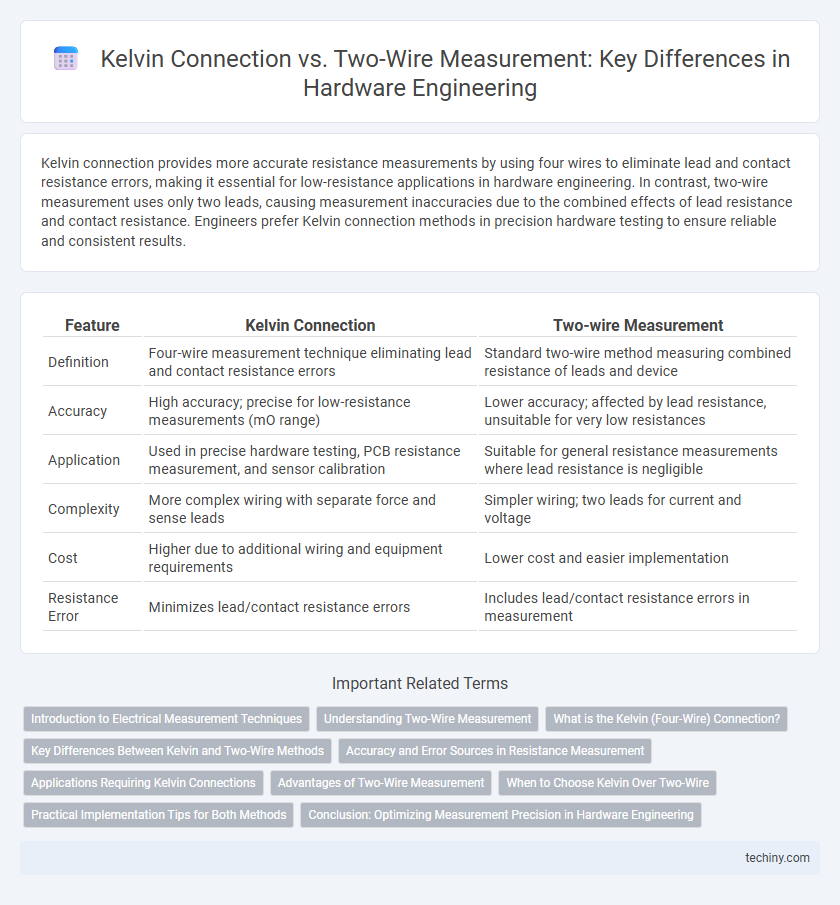Kelvin connection provides more accurate resistance measurements by using four wires to eliminate lead and contact resistance errors, making it essential for low-resistance applications in hardware engineering. In contrast, two-wire measurement uses only two leads, causing measurement inaccuracies due to the combined effects of lead resistance and contact resistance. Engineers prefer Kelvin connection methods in precision hardware testing to ensure reliable and consistent results.
Table of Comparison
| Feature | Kelvin Connection | Two-wire Measurement |
|---|---|---|
| Definition | Four-wire measurement technique eliminating lead and contact resistance errors | Standard two-wire method measuring combined resistance of leads and device |
| Accuracy | High accuracy; precise for low-resistance measurements (mO range) | Lower accuracy; affected by lead resistance, unsuitable for very low resistances |
| Application | Used in precise hardware testing, PCB resistance measurement, and sensor calibration | Suitable for general resistance measurements where lead resistance is negligible |
| Complexity | More complex wiring with separate force and sense leads | Simpler wiring; two leads for current and voltage |
| Cost | Higher due to additional wiring and equipment requirements | Lower cost and easier implementation |
| Resistance Error | Minimizes lead/contact resistance errors | Includes lead/contact resistance errors in measurement |
Introduction to Electrical Measurement Techniques
Kelvin connection, also known as four-wire sensing, significantly improves accuracy in electrical measurements by eliminating the effect of lead and contact resistance, which is a common issue in two-wire measurement setups. In two-wire measurement, the same pair of wires carries current and measures voltage, causing errors in resistance measurement, especially for low-resistance components. Utilizing Kelvin connections enables precise voltage sensing directly at the test specimen, enhancing the reliability of hardware engineering diagnostics and calibration processes.
Understanding Two-Wire Measurement
Two-wire measurement involves using a single pair of wires to carry both the current and voltage signals, which often leads to inaccuracies due to the voltage drop in the leads. This method is simpler but less precise because the resistance of the test leads adds to the measured resistance, making it unsuitable for low-resistance measurements. Understanding the limitations of two-wire measurement highlights the need for alternative techniques like Kelvin connection, which separates current and voltage paths to eliminate lead resistance errors.
What is the Kelvin (Four-Wire) Connection?
The Kelvin (Four-Wire) Connection is a precise method for measuring electrical resistance by using separate pairs of current-carrying and voltage-sensing electrodes. This technique eliminates errors caused by lead and contact resistances, making it essential for low-resistance measurements in hardware engineering. Compared to the Two-wire Measurement, the Kelvin connection significantly enhances accuracy and reliability in applications such as PCB testing, sensor calibration, and component characterization.
Key Differences Between Kelvin and Two-Wire Methods
Kelvin connection employs a four-wire method to measure voltage, significantly reducing errors caused by lead and contact resistance, unlike the two-wire measurement that combines current supply and voltage sensing in the same leads, leading to voltage drop inaccuracies. This four-wire technique is essential for low-resistance components and precision measurements, ensuring higher accuracy by isolating the sensing wires from the current-carrying paths. The two-wire method, while simpler and more cost-effective, is suitable for higher resistance measurements where lead resistance has a negligible impact.
Accuracy and Error Sources in Resistance Measurement
Kelvin connection provides superior accuracy in resistance measurement by eliminating lead and contact resistance errors inherent in two-wire measurements, making it ideal for low-resistance components. Two-wire measurement often suffers from significant error sources such as voltage drop across test leads and connection points, resulting in less precise readings. Utilizing a four-wire Kelvin connection ensures precise voltage sensing separate from current delivery, reducing measurement inaccuracies caused by parasitic resistances.
Applications Requiring Kelvin Connections
Kelvin connections are essential in applications requiring precise voltage measurements across low-resistance components, such as strain gauges, shunt resistors, and battery testing. They eliminate errors caused by lead and contact resistance by using separate current and voltage sensing leads, ensuring accurate and stable readings in high-precision hardware engineering tasks. Two-wire measurements, by contrast, are inadequate for such applications due to the intrinsic resistance of the measurement leads impacting accuracy.
Advantages of Two-Wire Measurement
Two-wire measurement offers simplicity and reduced cost by using only two leads for current and voltage measurement, minimizing wiring complexity and setup time. It is advantageous in applications where high precision is not critical, allowing faster testing and maintenance. This method is effective for measuring low-resistance components where lead resistance has a negligible impact on accuracy.
When to Choose Kelvin Over Two-Wire
Kelvin connection is preferred over two-wire measurement when precision in low-resistance measurements is critical, such as in testing PCB traces, connectors, and conductive materials where lead resistance and contact resistance can introduce significant errors. The four-wire setup of Kelvin connections eliminates lead and contact resistances by using separate pairs of current-carrying and voltage-sensing electrodes, ensuring accurate resistance readings down to microohms. This method is essential for high-accuracy applications in hardware engineering, including sensor calibration and microelectronic component testing.
Practical Implementation Tips for Both Methods
Kelvin connection significantly reduces measurement errors caused by lead and contact resistances in low-resistance testing by using separate pairs of current-carrying and voltage-sensing leads, making it highly effective in precision hardware engineering. In two-wire measurement setups, minimizing lead length and ensuring tight, clean connections can improve accuracy, but residual lead resistance remains a limiting factor for very low-resistance components. For practical implementation, using shielded cables and proper fixture design in Kelvin configurations enhances noise rejection, while two-wire measurements benefit from regular calibration and compensation techniques to approximate true resistance values.
Conclusion: Optimizing Measurement Precision in Hardware Engineering
Kelvin connection significantly reduces measurement errors caused by lead and contact resistances, making it essential for achieving high-precision voltage readings in hardware engineering. Two-wire measurement methods often introduce inaccuracies in low-resistance contexts, limiting their effectiveness in precision-sensitive applications. Employing Kelvin connections optimizes measurement accuracy, enhancing reliability and performance in advanced hardware design and testing.
Kelvin Connection vs Two-wire Measurement Infographic

 techiny.com
techiny.com